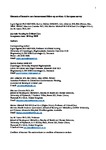Elements of intensive care bereavement follow-up services: A European survey
| dc.contributor.author | Egerod, I | |
| dc.contributor.author | Kaldan, G | |
| dc.contributor.author | Albarran, J | |
| dc.contributor.author | Coombs, M | |
| dc.contributor.author | Mitchell, M | |
| dc.contributor.author | Latour, J | |
| dc.date.accessioned | 2019-05-31T16:33:03Z | |
| dc.date.issued | 2019-07 | |
| dc.identifier.issn | 1362-1017 | |
| dc.identifier.issn | 1478-5153 | |
| dc.identifier.uri | http://hdl.handle.net/10026.1/14226 | |
| dc.description.abstract |
Background: Despite technological innovations and continuous improvement in evidence-based treatments, mortality in the intensive care unit remains high. Consequently, a large group of family members may be in need, and benefit from bereavement follow-up support. Aim: To explore elements, organization, and evaluation of ICU bereavement services in European countries. Specific objectives were to investigate: 1) the model of bereavement follow-up services (elements of support), 2) the workforce model (organization of staff), 3) the evaluation model (evaluation strategies). Study design: Cross-sectional survey of conference delegates. Methods: A paper and pen questionnaire including a cover letter assuring the respondents of anonymity and confidentiality was distributed to 250 delegates during the opening ceremony of the 2017 European federation of Critical Care Nurses associations (EfCCNa) Congress in Belfast. The questionnaire was developed from a previously validated tool describing bereavement care practices in intensive care units including questions about the content and organization of bereavement follow-up services. Frequencies were calculated in yes/no questions and content analysis was applied in additional free text comments. Results: We received 85 responses from publicly employed nurses, mainly in mixed adult ICUs. Respondents were 48 (56.5%) bedside nurses and the rest represented clinical nurse specialists, researchers, managers, or academic nurses. Bereavement follow-up had existed about 1-15 years. Important follow-up elements were: viewing the deceased in the unit 77 (90.6%), providing follow-up information 67 (79.8%), sending a letter of sympathy 17 (20%), and calling the family to arrange a meeting 27 (31%). Conclusion: Bereavement follow-up is common, but variable at European intensive care units. We recommend the development, implementation, and evaluation of evidence-based, but culture-specific, bereavement follow-up guidelines for European intensive care units. Relevance to Clinical Practice: More critical care nurses are realizing the need for bereavement follow-up guidelines. This paper provides an overview of common elements that might be considered. | |
| dc.format.extent | 201-208 | |
| dc.format.medium | Print-Electronic | |
| dc.language | en | |
| dc.language.iso | en | |
| dc.publisher | Wiley | |
| dc.subject | bereavement | |
| dc.subject | critical care nursing | |
| dc.subject | family-centred care | |
| dc.subject | grief | |
| dc.subject | ICU follow-up | |
| dc.subject | questionnaire design | |
| dc.subject | survey | |
| dc.title | Elements of intensive care bereavement follow-up services: A European survey | |
| dc.type | journal-article | |
| dc.type | Article | |
| plymouth.author-url | https://www.ncbi.nlm.nih.gov/pubmed/31237406 | |
| plymouth.issue | 4 | |
| plymouth.volume | 24 | |
| plymouth.publication-status | Published | |
| plymouth.journal | Nursing in Critical Care | |
| dc.identifier.doi | 10.1111/nicc.12459 | |
| plymouth.organisational-group | /Plymouth | |
| plymouth.organisational-group | /Plymouth/Faculty of Health | |
| plymouth.organisational-group | /Plymouth/Faculty of Health/School of Nursing and Midwifery | |
| plymouth.organisational-group | /Plymouth/REF 2021 Researchers by UoA | |
| plymouth.organisational-group | /Plymouth/REF 2021 Researchers by UoA/UoA03 Allied Health Professions, Dentistry, Nursing and Pharmacy | |
| plymouth.organisational-group | /Plymouth/Research Groups | |
| plymouth.organisational-group | /Plymouth/Research Groups/Institute of Health and Community | |
| plymouth.organisational-group | /Plymouth/Research Groups/Plymouth Institute of Health and Care Research (PIHR) | |
| plymouth.organisational-group | /Plymouth/Users by role | |
| plymouth.organisational-group | /Plymouth/Users by role/Academics | |
| dc.publisher.place | England | |
| dcterms.dateAccepted | 2019-05-30 | |
| dc.rights.embargodate | 2020-6-24 | |
| dc.identifier.eissn | 1478-5153 | |
| dc.rights.embargoperiod | Not known | |
| rioxxterms.version | Accepted Manuscript | |
| rioxxterms.versionofrecord | 10.1111/nicc.12459 | |
| rioxxterms.licenseref.uri | http://www.rioxx.net/licenses/all-rights-reserved | |
| rioxxterms.licenseref.startdate | 2019-07 | |
| rioxxterms.type | Journal Article/Review |


